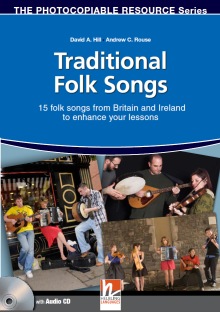Traditional Folk Songs:15 folk songs from Britain and Ireland – Auto-review
David. A. Hill, Hungary
Traditional Folk Songs:15 folk songs from Britain and Ireland
David A. Hill & Andrew C. Rouse
Helbling Languages
2012

Auto-review by one of the authors, David A. Hill, including some background to the genesis of the book, which might be illuminating for existing and would-be authors of ELT materials.
I first met Andy Rouse back in the early 1990s when we were both training for Pilgrims in Canterbury. We found a mutual love of traditional folk songs then, and performed on a few occasions for staff and students. We met again when I moved to Budapest, Hungary in 1998; Andy is a long-time resident near Pécs, a 3-hour train journey south. We have performed intermittently since then with another sometime Pilgrims trainer living in Hungary, Andrew Wright, as part of a group called Triumvirate. We take a theme and have a programme where Andy sings a song, Andrew tells a story and I read a poem related to the theme. It has been very popular at IATEFL Hungary Conferences and elsewhere.
It was at one of these get-togethers that Andy and I first discussed the idea of doing a book on traditional folk songs together for the ELT market. I had already published an article on the topic in MET (1999: Vol 8/2), and Andy taught folk song as a cultural artifact at Pécs University. We started getting together a list of possible songs to include, and we kicked around ideas for what format it might take. I then thought about publishers who might be interested, and eventually offered the proposal to Helbling Languages, with whom I had already worked on a number of projects. Initially I thought it might be part of their Resourceful Teacher series of recipe books (for which Andrew Wright and I had already written Writing Stories), however, at first they wanted it to be similar to a supplementary book for students in Germany that they had already published on pop songs.
I started writing it in that way, but then, as Helbling developed their new Photocopiable Resource series, they decided it should be part of that instead. This was fine by me, because it gave me much more room to manoeuvre. So with Andy providing the texts of some of the songs from his regular repertoire, and me providing some from mine, plus adding 4 songs which Helbling sensibly thought should be there because they were well-known by most teachers, we set to work. Andy researched the background to the historical contexts of many of the songs, and, as I am a textbook author as my daytime job, I bashed them into the required format.
What we have ended up with is a spiral-bound, A4 size book of 15 traditional folk songs, each with a set of at least five photocopiable worksheets for students to use and a set of Teacher’s Notes on how one might use the worksheets. The worksheets cover the following: CLIL aspects of the background to the songs, often historical; the words of the song, with a glossary of difficult lexis, and the melody; an exploration of the content of each song; language activities on relevant elements in each song; a final one called Performers’ Corner, where we examine the interpretation of each song by one particular singer or band. In these last worksheets we have a wonderful variety of styles from Sinead O’Connor and Simon & Garfunkel through Van Morrison and Pete Seeger, to heavy metal Queensryche, crossover classical Sarah Brightman and the rock of Traffic!! These are cross-referenced to performances on CD and on YouTube, with activities for teachers and students based on listening and viewing.
The final element of the book is the CD of the songs which goes with it. Andy and I recorded these, him unaccompanied solo and together with two regular members of his band Simply English on violin and guitar, and me unaccompanied solo or with my guitar. We all joined in with the choruses on four of the songs. I must say that it makes for good listening, regardless of the book!
What I hope is that this will prove a very useful set of supplementary resource materials that each school or English Department will want to have and use. The Introduction to the book makes it clear that teachers can use as many or as few of the Worksheets provided as they like. Whilst there is a suggested plan based on a three-lesson sequence using all of the Worksheets, teachers are free to explore what aspects they and their students would like to try out. The minimum would be to photocopy the words and listen to the song and then talk about it.

Please check the Teaching through Music and Visual Art course at Pilgrims website.
Please check the British Life, Language and Culture course at Pilgrims website.


|